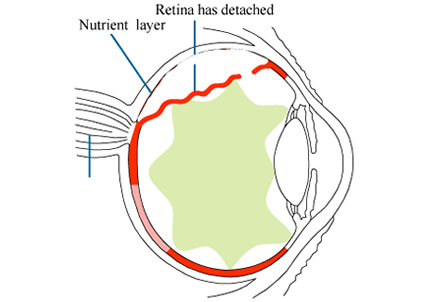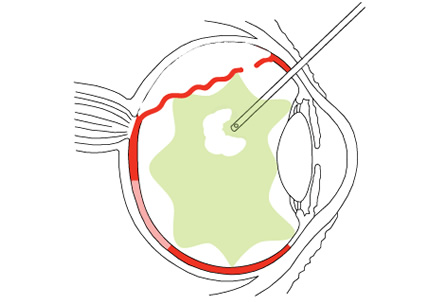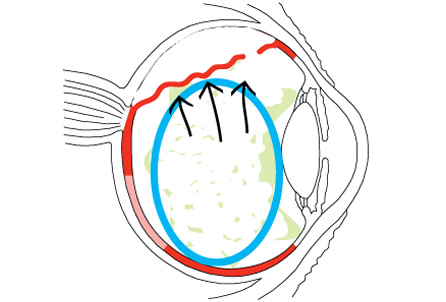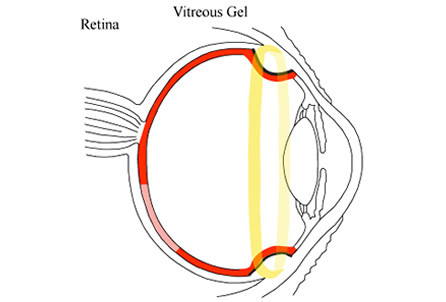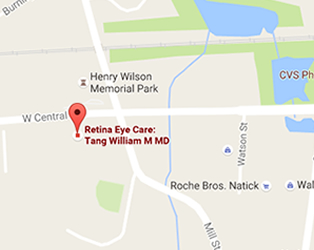Retinal Detachment
(Torn & Detached Retina)
Overview
Retinal detachment is usually caused by abnormal aging in the vitreous gel. The vitreous gel contracts, pulls, and tears the retina. The retina then becomes dislodged from the back of the eye, resulting in a shadow or vision loss. A retinal detachment often requires surgery for repair. If you have a retinal detachment in one eye, you must have the other eye monitored in the future, since the other eye has an increased chance of developing a retinal detachment also.
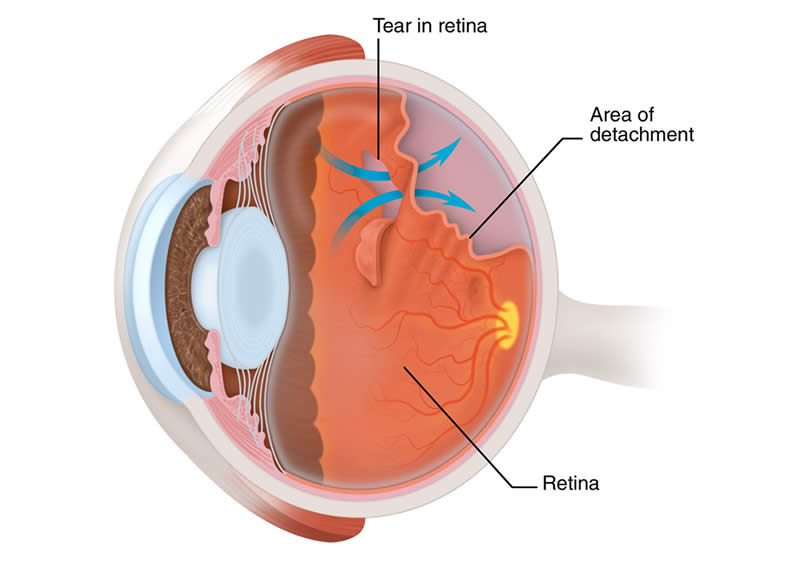
Causes
Retinal detachment usually comes from abnormal pulling forces of the vitreous gel. This usually happens at a certain age when the vitreous gel starts to mature and contract. The vitreous gel pulls on the weak part of the retina, causing the retina to be torn and dislocated. The common risk factors of this type of retinal detachment are:
- Age
- Family history (genetics)
- Nearsightedness
- Severe eye trauma
- Inflammation
- Previous eye surgery (especially if complicated)
Symptoms
You may notice sudden new floaters in your vision. The floaters can look like one piece of large web or strand, or there can be thousands of tiny little floaters. Each person’s floaters can look somewhat different. The tiny little floaters are actually red blood cells or pigment cells, and their presence suggests a higher chance that there is a retinal tear or detachment. However, it is important to not completely rely on the absence of floaters. Sometimes the floaters in retinal detachment can be subtle. Occasionally a retinal detachment can develop without any floaters.
You may see flashes, or streaks of light. Flashes in retinal detachment are usually split-second or few-seconds at a time. They can be like streaks of lightning, noticeable especially in a dark room. They can occur randomly at different times of the day. They can be quite alarming. They usually occur at the side of the vision. Sometimes you can induce a flash or a streak of light by moving your eyes from side to side quickly. Having flashes does not mean you will have a retinal detachment. Many patients see flashes without any retinal tear or detachment. On the other hand, some patients can develop a retinal detachment without seeing any flashes.
If you notice a shadow or a shade or a thumbprint in your vision, especially from the bottom or top or from the sides, this can mean your retina has detached, and you may need surgery to repair the retina. However, sometimes a patient can have a retinal detachment but yet unaware of any shadow in the vision.
If you suspect you may have a retinal detachment, you should contact a retina specialist.
treatments
There are many treatment modalities for retinal detachment. Depending on the situation, one or a combination of these modalities can be used to repair the retinal detachment. The treatment modalities include:
- Vitrectomy
- Scleral buckling
- Laser photocoagulation
- Pneumatic retinopexy (gas bubble)
- Cryotherapy (freezing of the retina)
A detached retina can no longer provide vision because it has been pulled away from the nutrient layer.
After vitreous gel removal, a gas bubble is used to keep the retina reattached until the retina becomes stable again.
Vitrectomy is an outpatient surgery. The surgery clears away the main bulk of the abnormal vitreous gel, and so relieves the pulling forces on the retina. The abnormal retina is treated by cryotherapy (freezing) and/or laser. The vitreous gel is then replaced by a gas bubble to help hold the retina in place until the reattachment becomes stable. The gas bubble usually dissipates over the next 1-2 months and is replaced by the eye’s own natural aqueous fluid. Usually you have to keep a face-down position for several days after surgery. While there is any gas bubble in the eye, you must not go on an airplane trip or undergo any other surgical procedure that uses gas.
Scleral buckling means a small silicone band is placed around the eye. This can help to relieve the pulling forces of the vitreous.
In certain cases, a gas bubble injection alone can be done to reattach the retina. Since the pulling forces of the vitreous gel may continue to exist, the chance for successful reattachment is not as high as surgery.
In certain cases, a laser treatment alone can be used to stop a retinal detachment.
Outlook
Retinal detachment is a serious condition. The chance for successful reattachment of the retina often can be very good. However, having a retinal detachment is a major setback for the health of the eye. Even after successful reattachment, the vision may be limited by a variety of factors.

